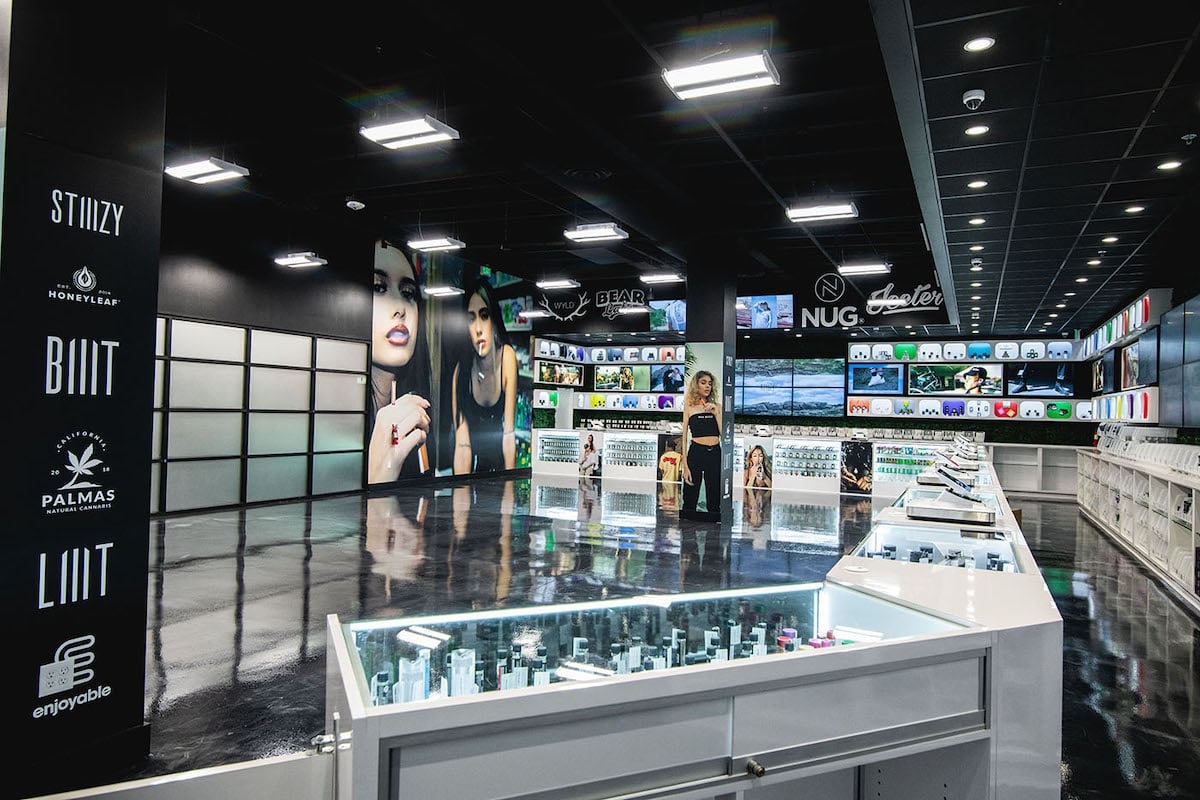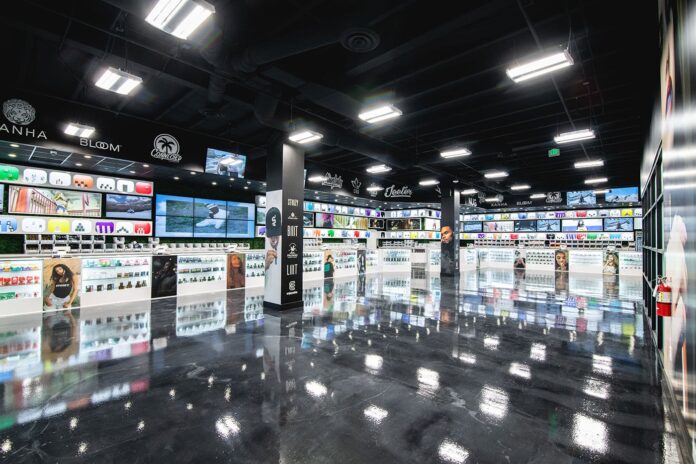Temeka Group boasts thirty-one years of experience working with clients including the National Football League, National Basketball Association, and Princess Cruises, completing more than 5,000 stores across multiple industries.
Four years ago, the Temeka team brought its expertise to cannabis retail. Since then, the company has worked with more than 160 cannabis businesses, from multistate operators to startups, to transform the companies’ visions into retail designs that elevate their brands and the industry as a whole. Temeka Group also offers services including millwork, fixtures, installation, graphics, and signage design and production.
Here, visionary owners Mike Wilson and Paul Nieboer offer insight about retail design best practices, market opportunities, and how retailers can capitalize on emerging trends in store design.
Your company helps brands craft physical spaces in which to tell their story. Can you briefly describe your process?
Every brand has a dream, a vision, and a story. However, brands sometimes struggle to translate their story to the physical space. Many of our cannabis clients bring us renderings or designs from their license application with comments like, “This is nice looking, but it just doesn’t seem to work for what we want,” or “This design is so far over our budget, we don’t know where to begin.” We’ve also had clients who won a license and secured financing but hadn’t thought about the brand experience at all.
When we meet with a client during the kickoff session, we ask questions about who they are, what makes them unique, and why a consumer would choose them over other retailers. Our objective is to listen, observe, and present back the client’s vision in the form of a physical space. We also share strategies for layering operational and compliance into the design, a consideration that is often overlooked.
Consumers are returning to brick-and-mortar stores, but their expectations have shifted with the availability of online shopping, curbside pickup, and delivery. What are the biggest opportunities to meet the changing needs of today’s cannabis consumers?
The biggest opportunity we see for retailers is to understand the different types of customers entering the store. New cannabis consumers enter a store with a lot of questions and education needs. They also take longer to make decisions and purchases. On the other end, experienced customers know what they want and are looking to get in and out quickly. At Temeka Group, we now design a lot of hybrid stores with integrated express lines, pickup counters, and bodega-style shopping with budtenders who encourage wandering and discovery, meeting the needs of all customer types.
Another opportunity exists when it comes to design concepts. We work with clients to develop flagship concepts for their A-plus locations while also developing scaled-down, budget-friendly concepts for their stores in smaller markets that remain on-point for brand experience. Developing these versions up front is more efficient than value-engineering on the fly.

“Connected brand experience” is trending in retail design. What does the concept look like in cannabis?
Our client Cookies is a great example of a connected brand experience. They know who they are and what experience they want to bring to their customer. Their brand’s social media channels and their in-store experiences are very connected and distinct from other brands. Cookies is not afraid to go into new markets with a unique look and feel, setting them apart from their competitors.
Stiiizy DTLA, for which Temeka Group designed furnishings, incorporates many interesting and interactive elements without losing sight of the store’s sales purpose. What is your top piece of advice for designing a retail environment that achieves the dual goals of delivering an experience and driving robust sales?
Stiiizy created a visionary, iconic flagship at their [downtown Los Angeles] location that the SoCal cannabis market needed. As part of the process, the brand recognized thousands of people would come through the doors every day, and they designed around the complete consumer experience. They focused on elements like parking management, number of point-of-sale registers, and a waiting area that was stimulating and interesting, creating a must-see dispensary.
Our top advice to cannabis retailers is to make an honest assessment of the location before jumping to design. Robust sales often get derailed when a retailer picks a poor location, which includes sites with limited parking or a building that doesn’t allow the experience the brand wants to give customers. A retailer can create the best design experience, but if the real estate doesn’t match the experience, customers will be frustrated and go elsewhere. Pick the right building!

Not all retailers have big budgets like Stiiizy or Cookies. What are some steps smaller operators can take to build unique experiences on a limited budget?
First, let’s talk about the elephant in the room: the company’s budget and building. Do your budget and building allow for the desired experience? Every dollar of your budget going into a new roof, new HVAC, or electrical upgrades takes away from the interior experience budget.
Second, let’s discuss timeline. Many clients tell us horror stories from launching their first dispensary—that it took months or years to open or cost too much. Often, someone has a friend who is excited and willing to help with architecture or construction, but they may not be the right person for the job. As retail design veterans with thirty years’ worth of experience, we often get businesses open several months earlier than expected while staying within budget, generating much-needed cash flow after the long licensing process. We also understand the challenges and costs of the licensing process and offer financing options to fit retailers of all sizes.
What are the most common missteps you see when retailers are planning their store design?
We often discuss this question in our team meetings. The most common issues we see include:
Not knowing sales projections or expected customer flow. A good example is when a retailer initially wants a bodega design until they realize they anticipate 1,000 customers a day. At that point, efficiencies need to be factored into the design.
Not understanding the true costs of retail build-out. These costs include furniture, fixtures, and equipment, as well as updates on poorly selected buildings. We have seen it all, from a building with less-than-eight-foot ceiling heights or buildings that needed all-new HVAC and sprinkler systems to buildings that were cheaper to demolish and build new.
Lacking plans for managing customer orders. Will the store have budtenders? Will product be fulfilled from back of house or from behind registers? Will product be on display or ordered from a menu? During past design kickoffs, we’ve found many clients hadn’t given much thought to these questions.
Involving friends and family to help with design and construction, especially when they have never worked on cannabis or other commercial projects. We have seen projects take nine months to complete when they should have taken two months. We have seen millwork that didn’t fit or was non-compliant. These situations may be further complicated when the friends or family members are investors or partners, resulting in too many cooks in the kitchen.
Taking shortcuts that negatively reflect on both the business and the industry as a whole. We always want to take the high road and be fully transparent with city officials while utilizing a good design, a good set of plans, and good contractors.
There’s lively debate about whether today’s consumers prefer to interact with screens or humans on the sales floor. What role does retail design play in combining emerging tech and the budtender experience to create a unique and desirable customer experience?
We love technology, and we also believe technology will not replace budtenders. We work with a great technology company that offers interactive retail displays to educate customers, improve capacity when budtenders are busy, and capture data on customer behaviors while on the screen. This in-store technology is powerful because the experience is like shopping on your phone at home: scroll, click, learn, add to cart, repeat.
Another great example is when the budtender interacts with technology while talking to the customer on their first visit. When the customer comes back later, they can go to the technology and fulfill their own order without the budtender. In essence, the customer gets to choose which experience they prefer.

What emerging retail design trends are you most excited about in the coming year?
We just finished the millwork and fixtures for the NFL flagship store in Las Vegas, and we loved the radio-frequency identification (RFID) technology the store incorporated to expedite checkout. Customers can drop their items into a bin at the register, and the screen will immediately come up with the total and be ready to charge the customer’s credit card, reducing delays.
We’re already seeing similar RFID technology at some California dispensaries. When a customer picks up a secure sniffer can of flower from a product display, the screen immediately tells them about the strain; shows photos, videos, and price; and asks if they want to add it to their shopping cart. Technology is evolving rapidly to enhance the brand experience and customer experience in ways that get us excited.
Looking ahead, what will Temeka Group be up to in the coming year?
Since expanding into cannabis, we have seen many of our clients struggle to manage licensing, compliance, and store openings. They were using everything from spreadsheets to databases, trying to force software to meet a specific need. These clients all thought they were the only ones struggling with keeping everything organized, but by our 100th cannabis retail client, we knew this was a common issue without a good solution.
In response, we launched a new company and developed a software platform called Greenspace designed to help cannabis operators manage projects including licensing and compliance, building, running, and scaling. We currently have twenty customers on beta, with plans to launch nationwide this summer. This software will be a game-changer for the industry, helping level the playing field for small to midsize companies to get open faster and better.













